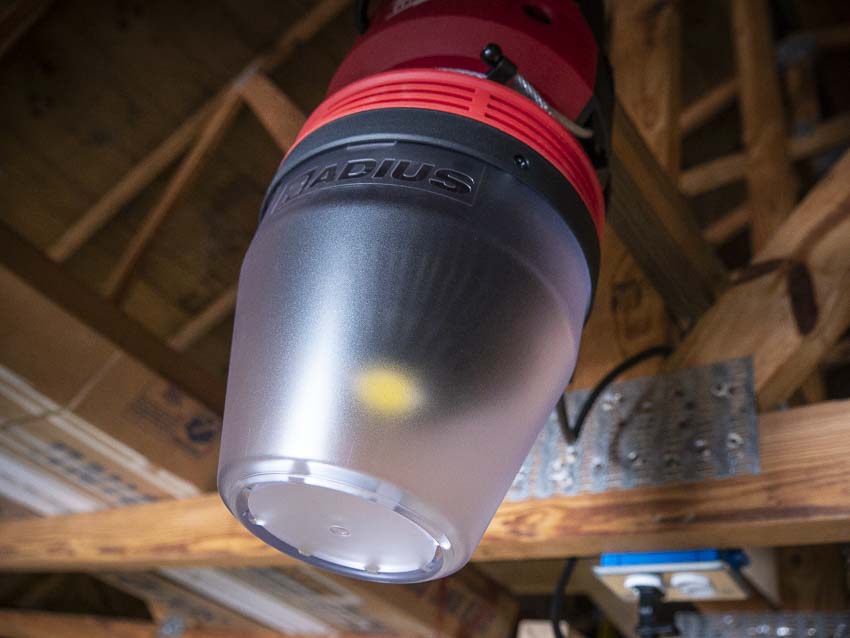Temporary site lights are a necessary part of many construction projects and buildings. Once properly configured, they install easily, and often we find contractors billing them to the job. Until a few years ago, HID remained the primary option for these low bay and high bay lights. These High Energy Discharge lights put out enough light (measured in lumens) to sufficiently cover the work area. Until LED, this remained the de facto standard for temporary high bay lighting. Fragility remained the downside to traditional HID lights. The Milwaukee Radius LED high bay temporary site light (2155-AC) offers a compelling LED-based choice that goes beyond standard high bay “cage” lights. The Radius LED high bay light uses an LED light panel that outputs 7700 lumens of 4000K (color temperature) light.
Temporary job site lighting is interesting. Typically, these high bay lights show up at a commercial job site by the pallet. They get dropped off at the prefab shop where they are wired up for either 120V, 208V, or even 277V. Every job site is different, and a good temporary light has to handle any of these configurations. Milwaukee took the route of streamlining the installation and prep process. They eliminated everything from the knockout to the external box. Everything is contained within the plastic housing and can be connected to an internal terminal block. The idea is that these lights can be reusable. Since they can handle drops and reconfigure easily for multiple voltages—reuse is likely. At the end of the job, collect them up for the next installation.
Milwaukee 70W Temporary Site Light (2155-AC) Build Quality
I’d say build quality defines the chief advantage of the Milwaukee Radius temporary light. The light uses a high-impact polycarbonate lens that can even be replaced. Since the light costs a premium over your traditional fluorescent or LED high bay light, your value comes from reuse. It also comes from a 5-year warranty and 50,000 bulb life. Considering the closest competition we could find comes with a 1-year warranty, and I can see really justifying the cost—even on a larger job site that may require dozens of lights.
Configuring the Milwaukee Radius LED High Bay
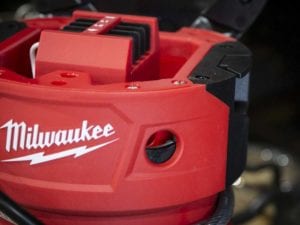
A fab shop working on the Milwaukee Radius High Bay light will quickly find that rewiring the light takes very little time. A single Philips screw opens up access to the terminal block. From here you can run straight Romex or MC cable. You can also (and likely will) daisy chain the lights together to run a series of them on a single circuit. If for some reason, you’re only connecting a few lights, Milwaukee prewires them with a standard 120V plug so you can connect them into an outlet.
For strain relief, Milwaukee provided two screws on each side of the terminal block that raise or lower a strain relief clamp to hold Romex or MC cable in place. This allows you to pass cable both in and through the Milwaukee Radius LED high bay light when running them in series. The system works well and seems fool-proof, though there are a lot of plastic parts which could wear out over time.
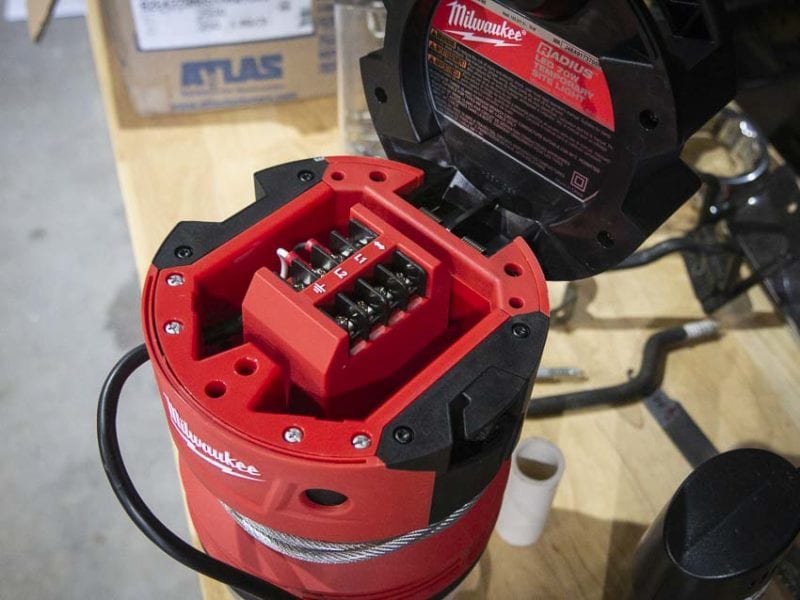
Instead of the 1/2-inch capacity hook, Milwaukee opted for a 4-foot long cable that can simply slide over a joist or beam and then lock into a one-way cam that holds the light in place. We found it simple to sling the wire around a mounting position and then lift the light while pulling the cable tight. Compare that to having to wrap a piece of Romex or wire around a joist several times and clip the light in place.
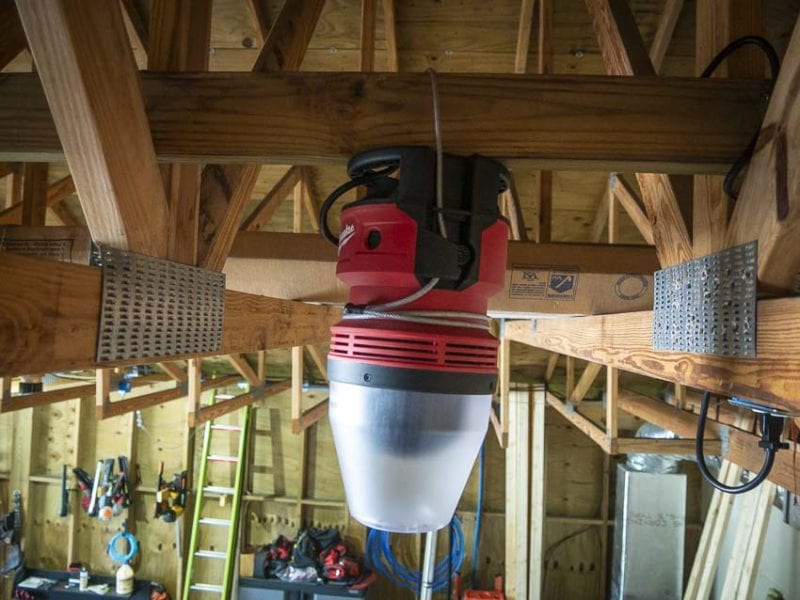
For reusability, Milwaukee also allowed the new Radius LED high Bay lights to stack vertically. The idea is that you can collect them after the job is done, remove the wiring, and store them for shipment to the next location.
In the event the lens hood does manage to break, you can replace it without having to replace the entire LED temporary light.
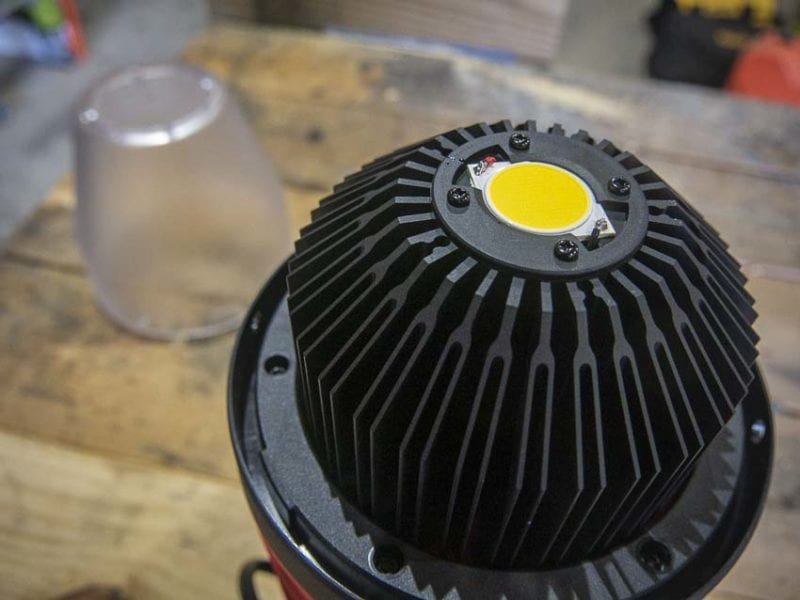
Comparing the Technologies
In terms of durability, a 105W fluorescent temporary light has around 10,000 hours of lifespan, and then it’s done. Because they’re fragile, they often don’t make it that long. HID lights simply run hot and take roughly 4X the power to operate. On a larger job that extends over a couple months, that’s going to cost you. Milwaukee designed the 2155-AC LED high bay light to last 50,000 hours. Then they backed it up with a 5-year tool warranty and limited lifetime LED warranty.
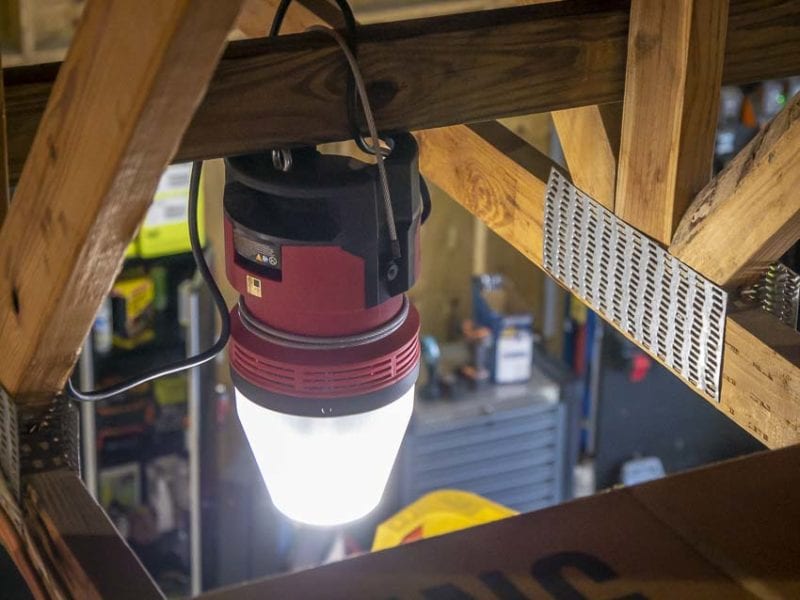
Here’s a quick feature comparison among some of the competition. A bold highlight represents something favorable or noteworthy.
| Milwaukee 70W LED High Bay | Hang-A-Light 105W Fluorescent | Hang-A-Light 60W LED | Southwire 78W LED Low Bay | |
|---|---|---|---|---|
| Lumens | 7,700 | 6,900 | 6,500 | 8,200 |
| Wattage | 70W | 105W | 60W | 78W |
| Color Temp | 3900K | 4000K | 5000K | 5000K |
| Bulb Life (hours) | 50,000 | 8,000 | 35,000 | 50,000 |
| Price | $199 | $90 | $159 | $110 |
| Warranty | 5 years | 90 days | 90 days | 1 year |
We like the similar Southwire LED low bay light, and the price is actually better, but the 1-year warranty makes it less appealing for repeat commercial use. Southwire also opted for a metal chassis and cage. This should protect the LED lamp but will suffer more damage than Milwaukee’s plastic lens housing in a drop. To go the other direction, the Appleton Baymaster LED high bay light provides tons of light with excellent build quality and very little portability.
Milwaukee 2155-AC Installation and Testing
We installed four Milwaukee Radius LED high bay lights in our shop loft. Immediately, we noticed the simplistic ease of installation. We had prewired the shop with joist-mounted 120V outlets, so the Milwaukee was prewired for our needs and even included a 3-foot cord. That made the job almost ridiculously simple. Add to that the integrated steel cable mounting method, and we found that we had all our lights installed in just a few minutes.
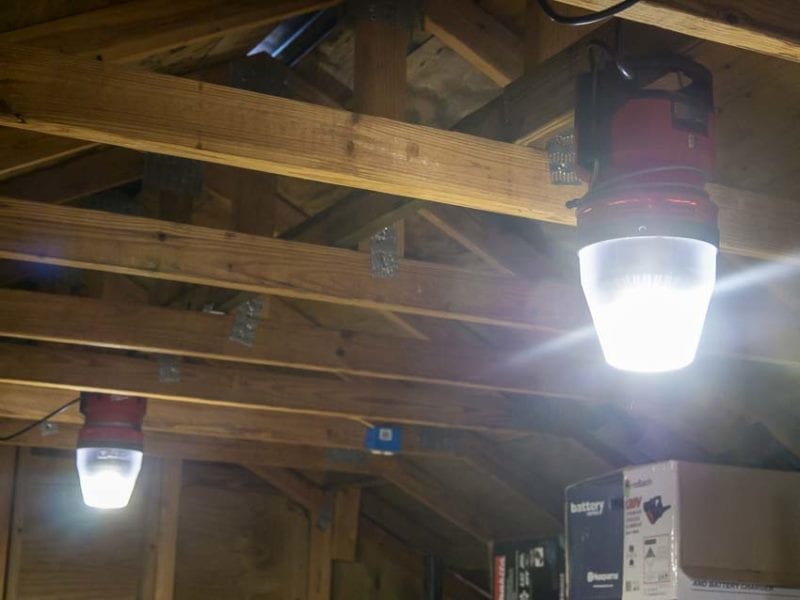
We also replaced one of the (non-Radius) lights in our main shop since the original had failed. We had gotten used to the half-second delay upon flipping the light switch to our shop. The Milwaukee Radius LED Temporary Site Light, however, pops on instantly with no delay. Chalk it up to better electronics or LED panels—but that’s actually a nice feature. In fact, it’s now factored into our LED light rating scale.
Editor’s Note: High Bay vs Low Bay: One of the things we noticed straight away was that the Milwaukee High Bay light behaved more like a low bay light. Despite the shape of the lens, it has a rather wide beam angle—around 120 degrees by our observations. It also doesn’t put out quite enough light to qualify as your typical high bay (over 10k lumens). As such, the Milwaukee light seems best-suited for applications with a maximum ceiling height of 16-20 feet. We’d tend to define high bay lighting placement as 20-feet or higher.
We measured the temperature of the Milwaukee 2155-AC temporary light and got around 138 degrees at the vents. The plastic lens cover, however, which shrouds the LED panel heat sinks, never exceeded 110 degrees.
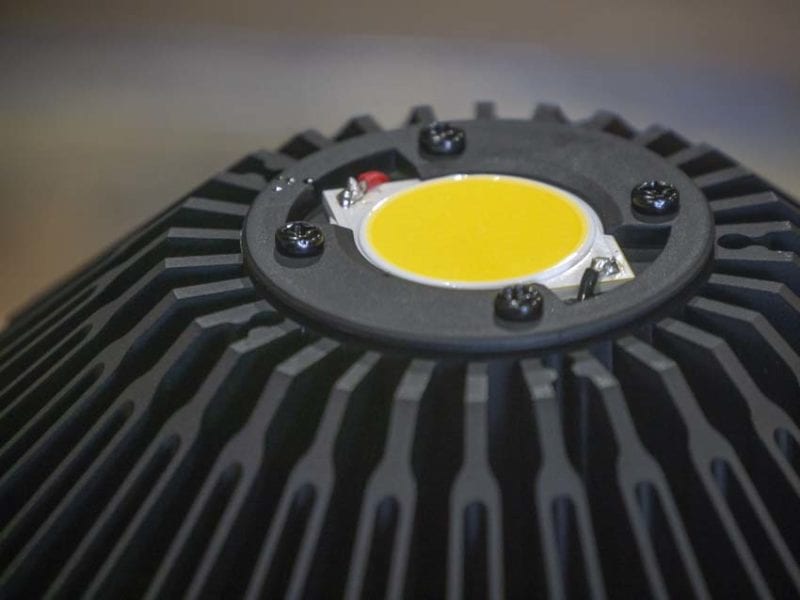
Milwaukee 2155-AC Temp Site Light Features & Specs
- Light output: 7700 lumens
- Color temperature: 3900K
- Voltage: 120-277V
- Integrated terminal block
- High impact polycarbonate lens (replaceable)
- Wire compatibility: Romex and MC cable
- Prewired 3ft 120V cord included
- Reusable and universal strain reliefs
- Integrated hang cable w/spring-loaded retention
- Dimensions (LxWxH): 6.5 x 6.5 x 13.75 in.
- Weight: 7.15 lbs.
- Warranty: 5-years (limited lifetime LED)
- Price: $199
Conclusion
First came the Milwaukee M18 Radius Site Light. That was great for packing in and out of a single, smaller work area. Now Milwaukee goes further into commercial job site lighting with temporary LED. If you don’t understand the pricing or potential for this type of light—it probably isn’t targeting you. If you run a fabrication shop or larger commercial crew, then this could potentially save you several thousands of dollars per job in power consumption, labor, and reusability.
The 3900K color temperature of the Milwaukee Radius LED 70W Temporary Site Light illuminates well. It’s a nice white that tends towards the warm spectrum, but not too much. You get accurate color representation for anything you’re working on without the “blue” hue higher color temperatures deliver. With the 5-year warranty, reusability, and ease of installation, it’s hard to not get excited about this light. A lot of manufacturers are slapping LED technology on older form factors. The Milwaukee Radius Site Light seems to have started from scratch. As such, they’ve developed something that delivers a lot of value—even though the price of entry may be steeper than other products already on the market.
Taking the long-view, it’s hard to justify fragile lighting in the age of LED. It’s equally unsavory to front the expense of “temporary” lighting that gets tossed after the first use. If you can’t get several jobs (or potentially years) out of your lights, you’re not operating as efficiently as you could. Milwaukee may have unlocked something here. As I get more feedback from our commercial Pros using the product, we’ll know if it holds up where the rubber meets the road.

